Mercado Medellín, or Medellin Market, located in Roma Sur, is my favourite farmer’s market in Mexico City. Not only is the marketplace large enough to feature everything you’d want in one place, it somehow still retains that friendly neighbourhood atmosphere. The market never feels too crowded and definitely not like it’s only there for the tourists. Shopping here makes you feel like a local and allows you to experience an authentic Mexican market. But knowing what to look for or what you’re looking at so hopefully, this guide will help you shop like a local with ease!
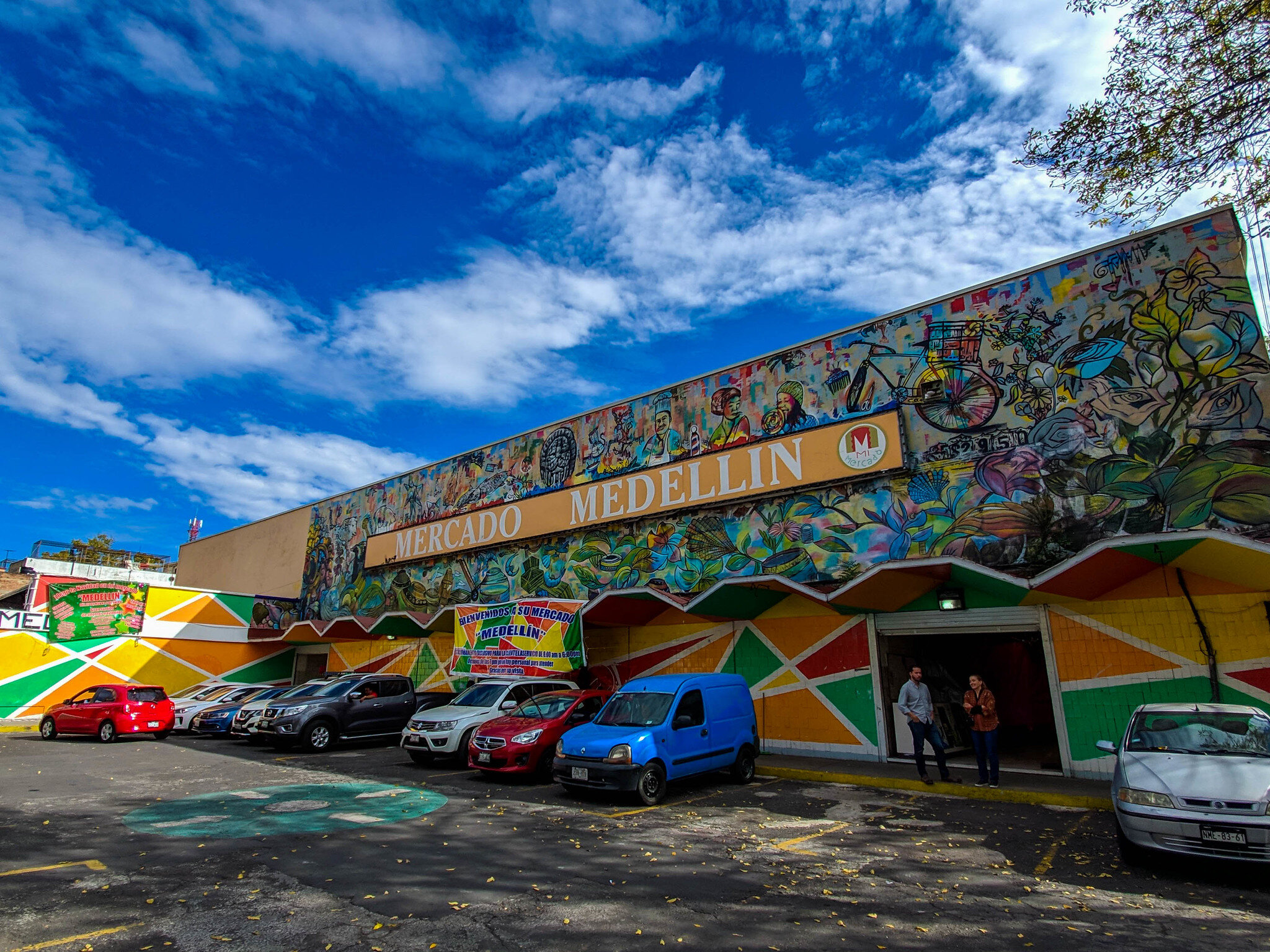
- History
- Flowers
- Tortillas de Arina
- Mexican Chili Peppers
- Moles Miguel
- Vanilla
- Dried Fruits & Nuts
- Productos Regionales Yucatecos y del Sureste
- Fruits and Vegetable Sellers
- Piñatas
- Lecheria
- Sugar Skulls
- Corn Tortillas
- Heladería Cubano
- Meat and Seafood
- La Morenita de Medellín
- La Flor de Xochimilco
- Meche y Rafael Carnitas
- Outside Street Food
- La Michoacana
- Tips for Visiting the Farmer's Market
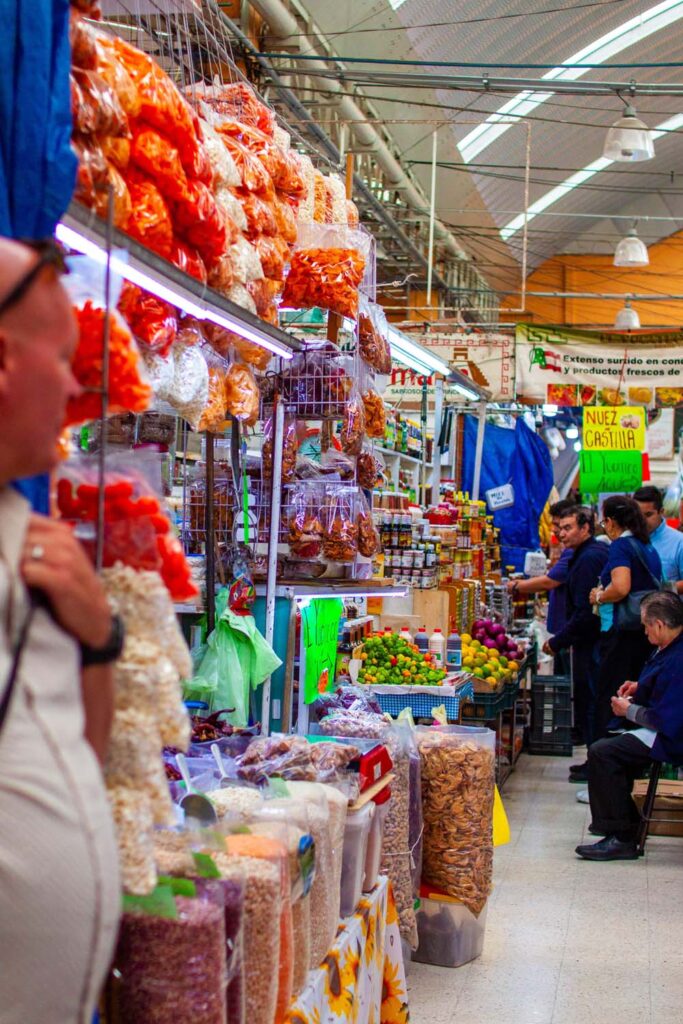
History
The Mercado Medellín is easily identifiable by it’s red, green and yellow geometric painted exterior. Lookout on one side for a huge, decorated multicolour mural. This marketplace has stood here for over 150 years. When the market was first established, it was in the centre of an immigrant community in Mexico City. Colombians, Cubans, Brazilian, Venezuelans and even Jewish immigrants all found themselves in the middle of the city in a neighbourhood now called Roma Sur.
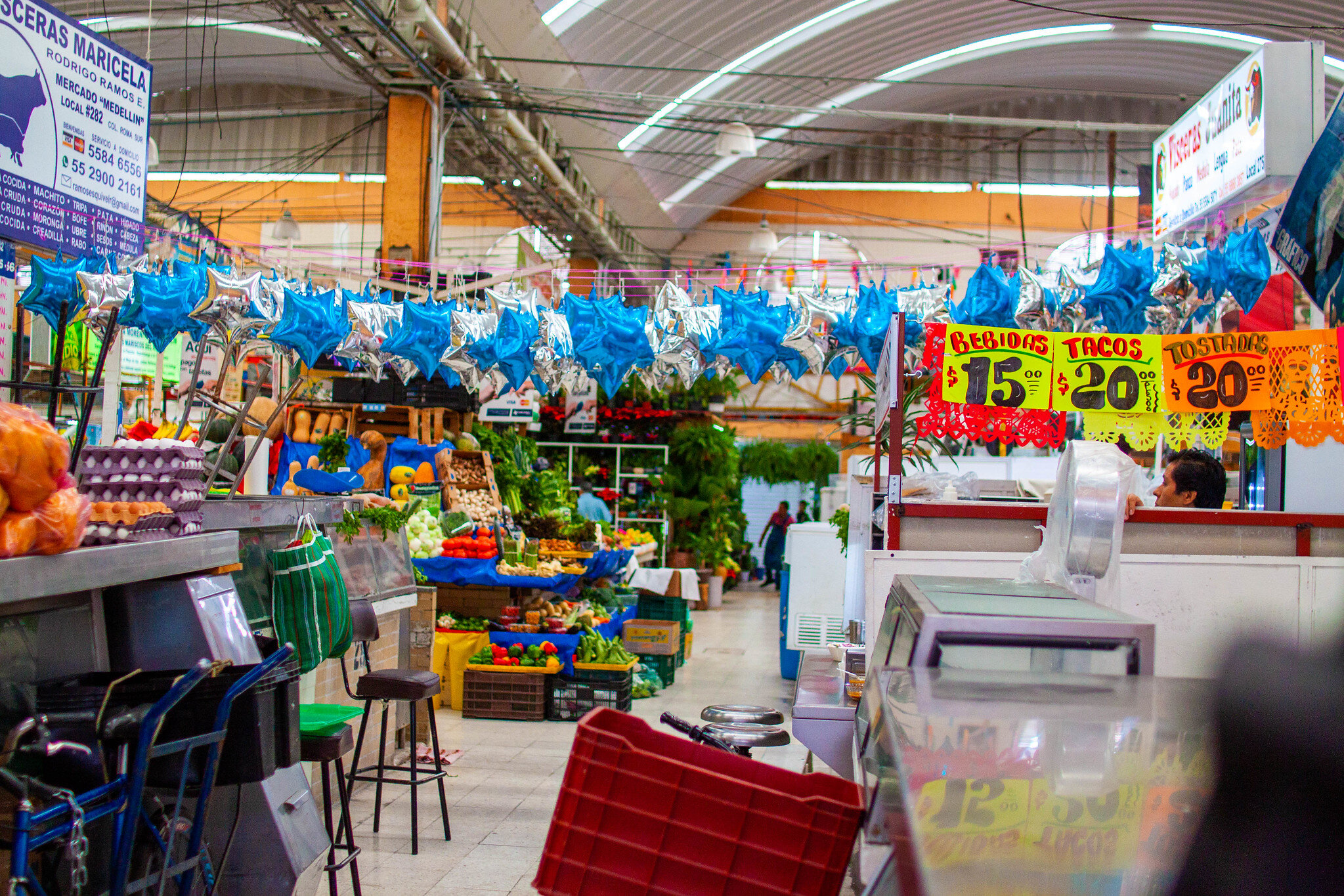
The immigrants would import food and goods from their home country to sell here in their new home in Mexico City. Up until the earthquake of 1985, Jewish Mexicans owned and operated the market. But after the quake, its ownership passed hands over to the Cubans, therein earning the market its nickname; “Little Havana.”

The entire marketplace is now home to over 500 different stalls. While you can have a blast just wandering around on your own, I’ve tried to highlight the key things you should see, buy and which are the best shops to visit!

Flowers
While this market can’t compete with the enormity of the Mercado Jamaica (the largest flower market in the city), the pre-made bouquets you’ll find here, beckoning you in from the street, are lovingly curated. After shopping for their food, we saw various locals come out and buy a bouquet from their favourite seller on their way home. A little something to brighten up their home for the week! Our favourite flower to see was the poinsettias for sale. Poinsettias, known as Flor de Nochebuena, are native to Mexico. In North America, the flowers are usually only seen around Christmas but here they actually grow as small trees or bushes. During the winter months, poinsettias can be spotted all over the streets and sidewalks of Mexico City.
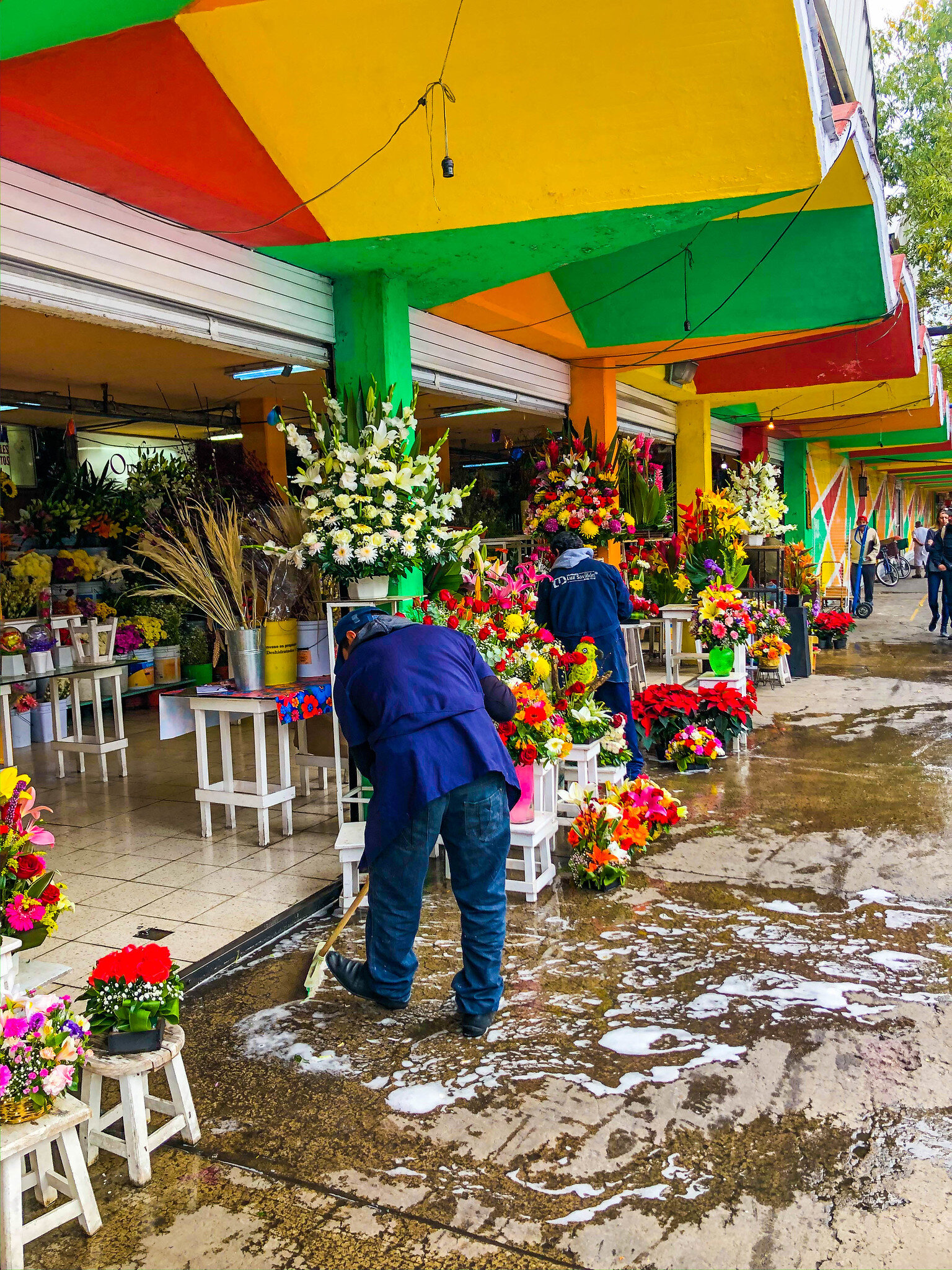
Tortillas de Arina
One of the first stalls to visit is ‘Tortillas de Arina.‘ This tortilleria makes flour tortillas for shops all across the city. Hundreds of tortillas speed off the conveyor belt, and the smell of freshly baked bread invites you to walk up and see what’s happening behind the counter. The word tortilla comes from the Spanish word for cake “torta” and “illa” means little. So it translates, the word for tortilla translates into “little cake.” The flour tortilla is much more popular with people from Northern Mexico. The close proximity to the border markets allowed Northern Mexicans to get inferior grade wheat flour, which they could make cheaply into flour tortillas. People who have moved from the northern provinces to Mexico City come here often to get their fix of wheat tortillas. Wheat tortillas are only usually only paired with Northern Mexican dishes.

Mexican Chili Peppers
This is one of the best markets to find fresh, Mexican Chili Peppers! There are five main chillies to see (perhaps even buy to take home with you); the Ancho, the Mulato, the Pasilla, the Morita and the Guajillo. The ancho chilli is the dried version of a poblano pepper. Ancho peppers are used in mole and many other recipes. Ancho is so popular because it has a subtle flavour with a hint of sweetness. Next up is the mulato chilli, also in mole. The mulato chihlli is also derived from the poblano pepper but picked when it first ripens, making it slightly spicier.

Pasilla chili
The final ingredient in the trifecta of mole chillies is the pasilla chilli. The pasilla are dried from chilaca peppers and are the darkest in colour. They are also much thinner and much spicier! Morita chipotles are chillies made by smoking ripe jalapeno peppers. These chipotles are not as strong in terms of a smokey flavour as some other, so really with this version, you get the best of both worlds.
The final chilles to find in the market is the guajillo chilli. Guajillo’s are long, flat, but small and are one of the spiciest varieties. Small packs a punch that’s for sure! It was so fascinating getting to touch and smell these chillies. The ones we get at home are so hard and almost crispy, but these dried peppers were soft and almost leathery. So if you’re a cook and want to make any Mexican recipe, these chillies are imperative to buy from these markets. Just be sure you know the customs regulations regarding these vegetables and always declare them to be sure.

Moles Miguel
Find your way to Moles Miguel, one of the most famous mole sellers in the market. This family-owned store sells pre-made mole pastes in different varieties. I never knew there were so many! If you ask nicely, they might even let you try a few before buying. Some of the most popular varieties are black mole, named for its super dark colour. This one is made with lots of cocoa beans (making it quite bitter). This one also has a more cinnamony taste than the rest. Then there is the red mole, made with dried red chiles like pasilla, guajillo and ancho. Finally, you’ve got the mole poblano. This version, in my opinion, is the best of them all. It’s sweet (but not too sweet) and just the right amount of smoke flavour.

Vanilla
Mexico is the birthplace of vanilla, and there is really no better place to buy it. Although the authentic extract is delicious, its even better to buy the bean pods fresh from sellers like you’ll find in these marketplaces. Fresh seeds are so much more fragrant than the extract since they aren’t diluted in alcohol.

Dried Fruits & Nuts
Dried fruits, nuts and seeds can be found all over the market, stashed away inside large tubs and baskets. Walnuts, called Castile nuts in Mexico, are of enormous importance during the late summer. Walnuts are a key ingredient to make one of Mexico’s most famous dishes, “chiles en nogada.” This dish is made with spicy green poblano peppers, stuffed with chopped meat and raisins. The dish is then topped with a thick sauce made from only cheese and ground walnuts. A sprinkling of pomegranate seeds creates the colours of the Mexican flag all in one dish!
The recipe was invited in honour of the leader of the Mexican uprising against the Spanish in the 19th century. Since the recipes invention, the dish eaten to celebrate Mexico’s Independence. Ironically, nuts were brought to Mexico by the Spaniards themselves. Almonds and peanuts are also an essential ingredient in mole as they add that deep, nutty flavour to the dish. Dried fruits from Mexico are beyond fresh, soft and flavourful. They are the perfect snack to stash away in your bag for an afternoon snack.

Productos Regionales Yucatecos y del Sureste
Many of the shops in the market sell pre-made mixes and pastes. From these you can create a myriad of Mexican recipes. Productos Regionales Yucatecos y del Sureste sells them all in one place. One of the most famous recipes in Mexican cuisine is Cochinita Pibil. The key ingredient to this recipe is Achiote paste. Achiote seeds are a traditional Aztec ingredient. The achiote paste is made from steeping the seeds in oil or lard. It’s thought to be like the saffron of Mexico. It’s so popular due to its sweet, earthy and peppery flavour. Buy it here and bring home to impress your friends.

Fruits and Vegetable Sellers
There are so many stands in this marketplace that have been run by the same family for generations. The food found here is an amalgamation of both locals and imported foods. Together they create the fabric of Mexico’s culinary culture.

A popular Mexican fruit that you may never have heard of is the mamey fruit. The mamey fruit has a rough rind, but a soft, coral coloured flesh underneath. When perfectly ripe, it tastes like a cross between a sweet potato and an orange. You’ll find these on menus all over Mexico, often as part of a beverage or served atop puddings.
Another odd ingredient you’ll find here is the nopal or cactus. “A cactus, you say?” Certain parts of the cactus are indeed edible and, when appropriately cooked, are shockingly delicious! To prepare the nopal, you slice off the exterior, scrap the spine, cut into slices, and boil with some simple spices. It’s incredibly cheap but very hearty food.

One of the last ingredients you might be on the lookout for is the tomatillo. You might know the tomatillo by its North American name, “green tomato”. But the Tomatillos found here in Mexico City as far different. They are much smaller and bursting with flavour. Tomatillos are used in all sorts of dishes. You can find them in salsas, salads and even soups! Tomatillos in the market are on display with their delicate pale husk on, which is removed before eating.

Piñatas
One thing which this market had plenty of is pinata makers. You can homemade pinatas all over the market. Some of which are still in the process of being made from scratch. When pinatas were first introduced to Mexico from Spain, they were symbolic of the Catholic belief in the deadly sins. The first pinatas weren’t shaped like Hello Kitty or Superman; they were seven-pointed stars, with each point representing a mortal sin. The person being blindfolded represented humanity’s blind faith in God needed to resist these temptations. The participant was spun around 33 times, once for every year of Christ’s life. Then the stick is used to beat the sins out of the faithful, and the candy and fruit represented the rewards for keeping the faith. You can still find these original designs in the marketplace today!

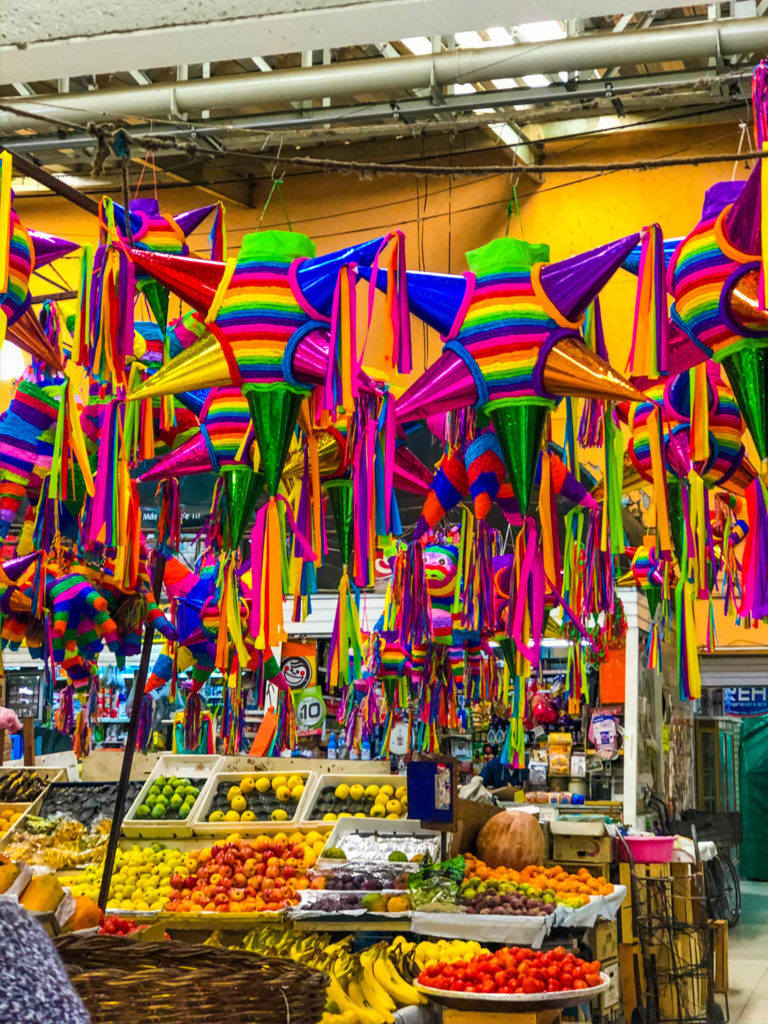
One of the oldest fruits to be included in the pinata was the tejocote. These are still sold today in the market, but have been replaced for sweet candy inside the pinatas. These Aztec fruits resemble a crabapple and are both similar in taste and shape but have the most beautiful golden colour.

Lecheria
Along the back wall, you can find a huge lecheria, which is Spanish for ‘dairy’ which sells a variety of cheese produced from local farms. My favourite is Oaxaca cheese. Oaxaca cheese is made from soft, stretched-curd cheese, made with cows’ milk. It pulls apart, almost like a cheese string (for those 90s kids reading), and if often served atop meals as it melts quickly and adds that perfect salty, umami flavour. The most interesting of the cheeses was the chihuahua, which is made from a Mennonite community in Mexico. Chihuahua cheese is relatively simple, with a buttery, yet sharp taste but very popular since its gentle flavour allows it to be paired well with most dishes.

See if you can also find or try some membrillo, which is a jelly made with quince juice and honey to be served alongside cheese. Together with the salty cheese, this sweet jam is perfection.

Sugar Skulls
Dia de Los Muertos (or Day of the Dead) was an Aztec ritual that celebrated the lives of those who were deceased. Despite the Spaniards attempt to rid the country of this sacred holiday, the ceremony remained. Eventually, it was blended together with the Catholic celebration of All Saints Day on November 1st. Traditional sugar skulls are a highly respected part of the day of the Dead rituals. Sugar was brought to Mexico in the 17th century by Italian missionaries. Sugar cane was so easy to grow in Mexico, so there became an abundance of it in the country.
History of Sugar Skulls
As Mexico was converting to Catholicism, it found that their churches didn’t match up to the opulence of the ones in Europe. Mexico didn’t have enough money to import decorations or cover their churches in gold. But what they did have was sugar, which they could produce cheaply and in vast quantities. So, using clay moulds, they used sugar to create angels, crosses and more to decorate the interior of their churches. Eventually, these kinds of decorations made their way into the celebrations of Day of the Dead. Sugar skulls were created to represent the soul of the departed, and their name was written upon the forehead of the sugar skull. They were then laid on the grave or ofrenda to honour the spirit of the beloved one who had past. You can find still these sugar skulls in the marketplaces around Day of the Dead.

Corn Tortillas
Freshly made Corn Tortillas can be found inside the market. Corn Tortillas were first invented around 10,000 BC when corn was domesticated in Mexico. Corn was linked to life in Mexico. It was their primary source of carbs (which equals energy). During the Aztec empire, one of the most popular dishes was tortillas, with chilli sauce, beans and squash. Today local workers still come to tortillerias to get fresh tortillas, salsa, rice and beans, which they will bring to the worksite to enjoy for their lunch. Just like it was thousands of years ago. Some things never change…

Heladería Cubano
Towards the back of the market, stop at Heladería Cubano. The kind gentleman behind the counter serves up Cuban ice cream and milkshakes. The milkshakes are made with fresh creme, sugar, ice (made from filtered water) and your choice of fresh fruit. He also can add malt to the milkshakes, which give you that retro flavour. Such an exciting thing to find in the middle of a Mexican marketplace but not at all unwelcome. The Cuban ice cream maker is famous in the market for his natural flavours and thick creamy ice cream!

Meat and Seafood
Take a step into the fresh meat and seafood area. Definitely the most fragrant area of the market but still very exciting. People are always yelling joyfully at each other from across the room and large meat cleavers can be heard smashing into hunks of beef and pork all across the room. This is usually where there is the most action, with locals, home cooks and restaurant chefs, coming here to buy their meats for the day.

La Morenita de Medellín
One of the most popular eateries in the market is ‘Marisquería,’ also known as “La Morenita de Medellín.” This is one of the only places in landlocked Mexico City where you can reliably find incredible seafood! Hidden away inside this marketplace, you can try red snapper from Veracruz, fish covered in garlic and chilis, pulpo al ajillo (cooked octopus), the devil’s oysters (oysters cooked in butter) and Mexican paella (which came over with Spanish). Reliably a great option if you’re craving seafood!

La Flor de Xochimilco
La Flor de Xochimilco is one of the most popular eateries inside the market. They specialize in taco de barbacoa. Barbacoa actually originates from the Caribbean. Taco de barbacoa refers to slow-cooked meats, over an open fire. The meat is cooked till its super tender. Then tacos are served with diced onions, cilantro and lime juice to help cut the fatty taste of the meat. If you’ve never had a barbacoa taco, this is a must!

Meche y Rafael Carnitas
At the back corner, hidden away, if THE place for carnitas, Meche y Rafael! Unfortunately, it’s only open on Saturdays. Pork was introduced to Mexico by the Spanish in the 16th century. Carnitas is a Spanish word that means “little meats.” Carnitas are made using lean pork mean, which is sliced and marinated in seasoning for hours. The fat cut from the meat is used for frying the carnitas before they are eaten. This carnitas stand serves up with bountiful portions alongside slices of the city’s best chicharrón. Douse the tacos with plenty of salsa and pickled radishes to cut the grease; while it might not be the healthiest food, it might be the most delicious.

Outside Street Food
Around the perimeter of the marketplace, are always a few reliable street food stands, run by some of the nicest local women. If you’re looking for something delicious to try, order up the tlacoyo. Tlacoyo is made from blue corn dough and filled with beans. It’s then fried on the grill. Once cooked, they are garnished with Oaxaca or cotija cheese, nopales, salsa and chicharrón. So filling, delicious and impossibly cheap! If you’re there earlier in the morning, be sure to try their breakfast version, which was made with fried potatoes with chorizo. It’s fantastic!
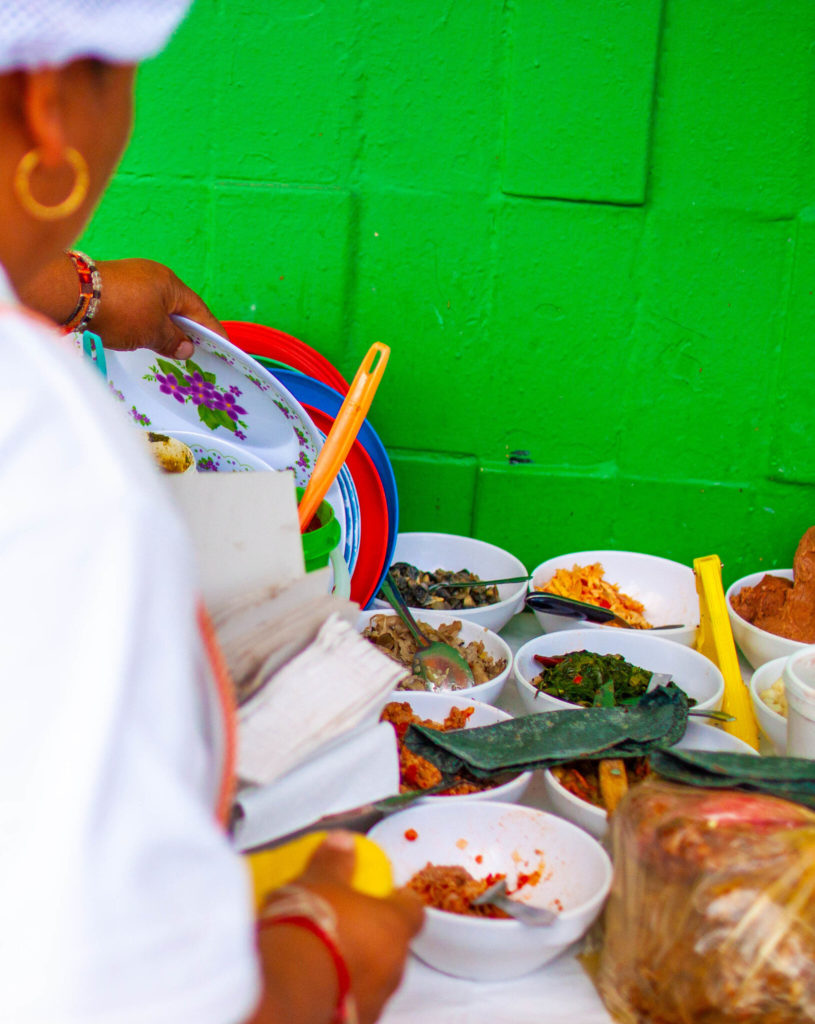
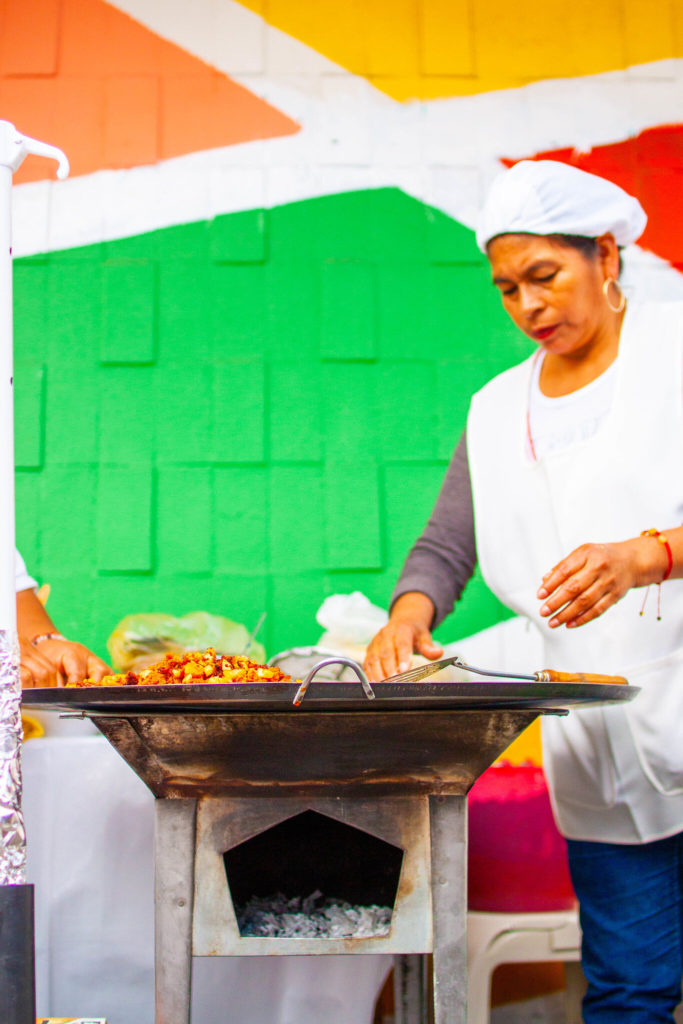
La Michoacana
If you are looking to sample an agua fresca, hit up the La Michoacana. La Michoacana is actually a chain of ice cream parlours in Mexico City. And although their ice cream is never quite up to snuff, their agua frescas are reliably some of the best! Just ask anyone behind the counter if they’re made with filtered water (agua pura) to be sure it’s safe to drink. Agua frescas are more than just juice, they are these incredible beverages flavoured with uniquely Mexican flavours like tamarind, hibiscus, and horchata!

Tips for Visiting the Farmer’s Market
- Always bring cash and small change. Most marketplaces don’t take credit cards, and if you plan on haggling at all, don’t even think about using a credit card. Cash is king in the market. But big bills won’t work either. Most of these sellers won’t have a lot of change, and early in the day, you might find that don’t have change at all. I always keep a stash of coins with me at all times to ensure I have the exact amount when shopping in markets like these. Having small coins is also important for using public washrooms in places like this, as most charge 5 pesos for the bathroom.
- Beware of Pickpockets. Although this marketplace is much less of a target than some of the most touristy markets in other parts of town, you should always be aware of your surroundings. Keep your money in safe places, not easily accessible by someone else. For me, I keep some smaller change in my pockets and any bigger bills deep in my bag, where it would take some time to access. But honestly, just keeping your awareness of what and who is around you is the most important part of keeping safe.
- Ask before touching any food. Most of the seller won’t mind if you touch the food, in fact to buy some fruits and vegetables you need to give it a squeeze to see if it’s ripe! But some tourists touch EVERYTHING and it really bothers the sellers. I’ve seen some tourists come in and mess up their entire display without so much as moving one thing back into place. Just ask nicely if you can look or touch something and respect what the seller responds with. But honestly, just asking will win you over with them!
- Think before taking a picture. Some of the vendors inside the more touristy markets take umbrage with tourists taking photos of their stalls. The main reason for this is they don’t always want to be on camera but also, they don’t see themselves as a tourist attraction. They would prefer you to buy something instead of just taking pictures and yet walking away without contributing to any of the vendors who need money to keep their businesses running. I always look for a “no photos” sign first before taking a picture since that’s pretty clear cut. Often, I’ll even ask the vendors if it’s ok. If you’re purchased something you’re almost always ok to take a picture since the seller knows you’re not just using them as a prop, but actually care about the product.
- Travel Light. These types of markets are fairly crowded, with narrow aisles and products overflowing over the edges of the counters. This means carrying a huge backpack with you might not be the best idea. I would stick to a small bag for your shopping and a crossbody bag for your valuables.
- Be friendly. Locals are proud of their produce. Some of these farmers sell the very things they harvested that morning to shoppers. Giving them a smile, a hello, goodbye or good afternoon goes a long way in acclimatizing yourself into this neighbourhood market.
- If you don’t recognize something, don’t be afraid! Trying new things is what travelling is all about! The food at this market is incredibly fresh. These stands only stay open until 4 or 5 pm so the turn over is daily and nothing just gets left behind. The only thing I really avoid is water washed veggies, like salads, but anything cooked is fair game!
Learn some key Spanish phrases
When shopping in a local market like this you might not find a lot of people who speak English. To make a good impression and fit in with the locals, try to learn a few phrases. The most important phrases are the ones to do with prices so you’ll understand how much everything costs. I would recommend avoiding any haggling if you don’t speak Spanish competently since you’ll get over your head pretty fast.
Here are some of my key phrases for shopping:
good morning // Buenos días
good afternoon // buenas tardes
goodbye // adiós
how much? // Cuánto cuesta?
one, two, three // uno, dos, tres
What is this? // ¿Que es esto?
Thank you // Gracias
no, thank you // no, gracias
Can I touch? // ¿Puedo tocar?
Can I take a photo? // ¿Puedo tomar una foto?

We first came to the market on a guided tour with Casa Jacaranda. I cannot recommend their cooking experience more so if you are interested in learning more about Mexican cuisine and Markets in Mexico check them out!

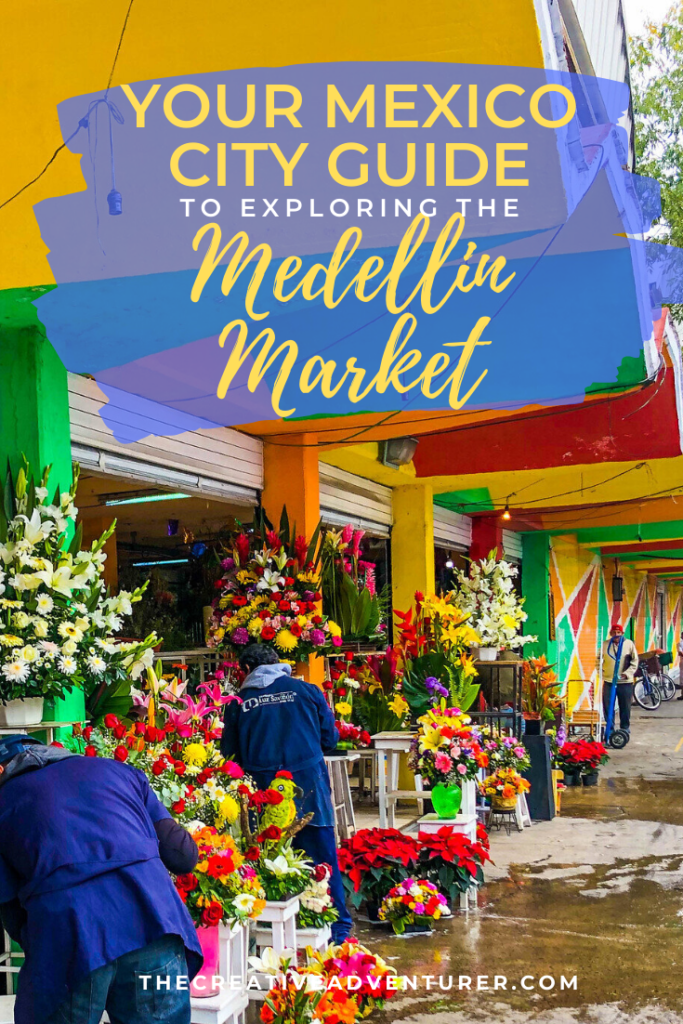

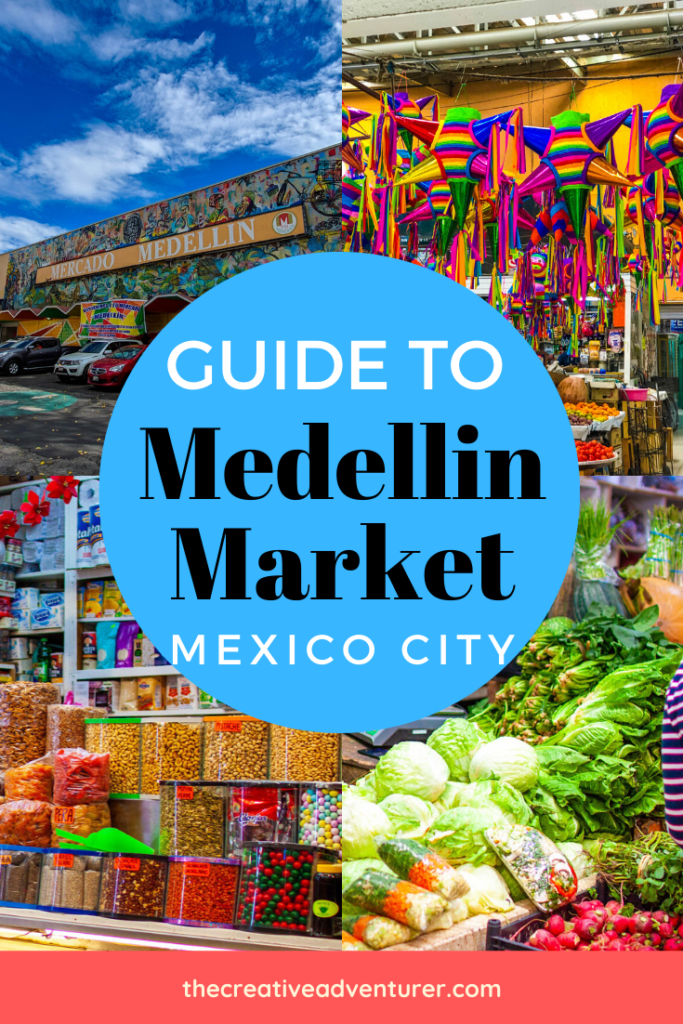


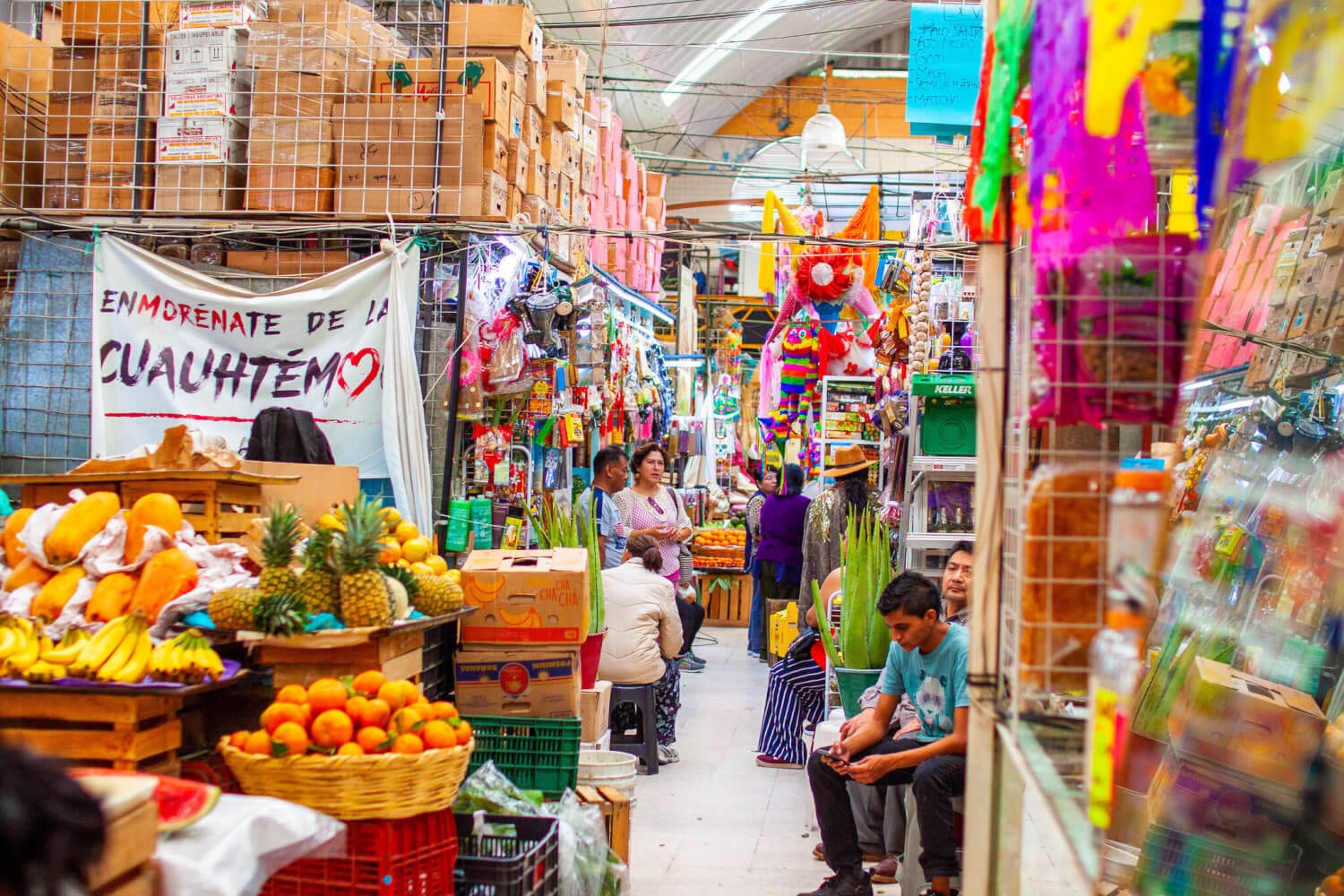
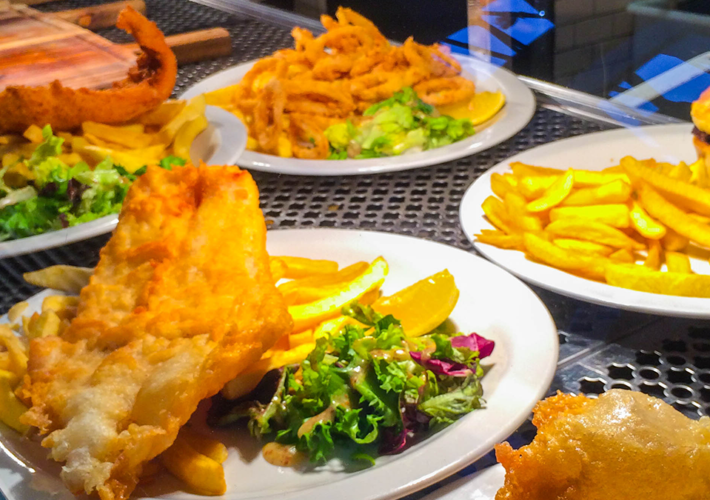
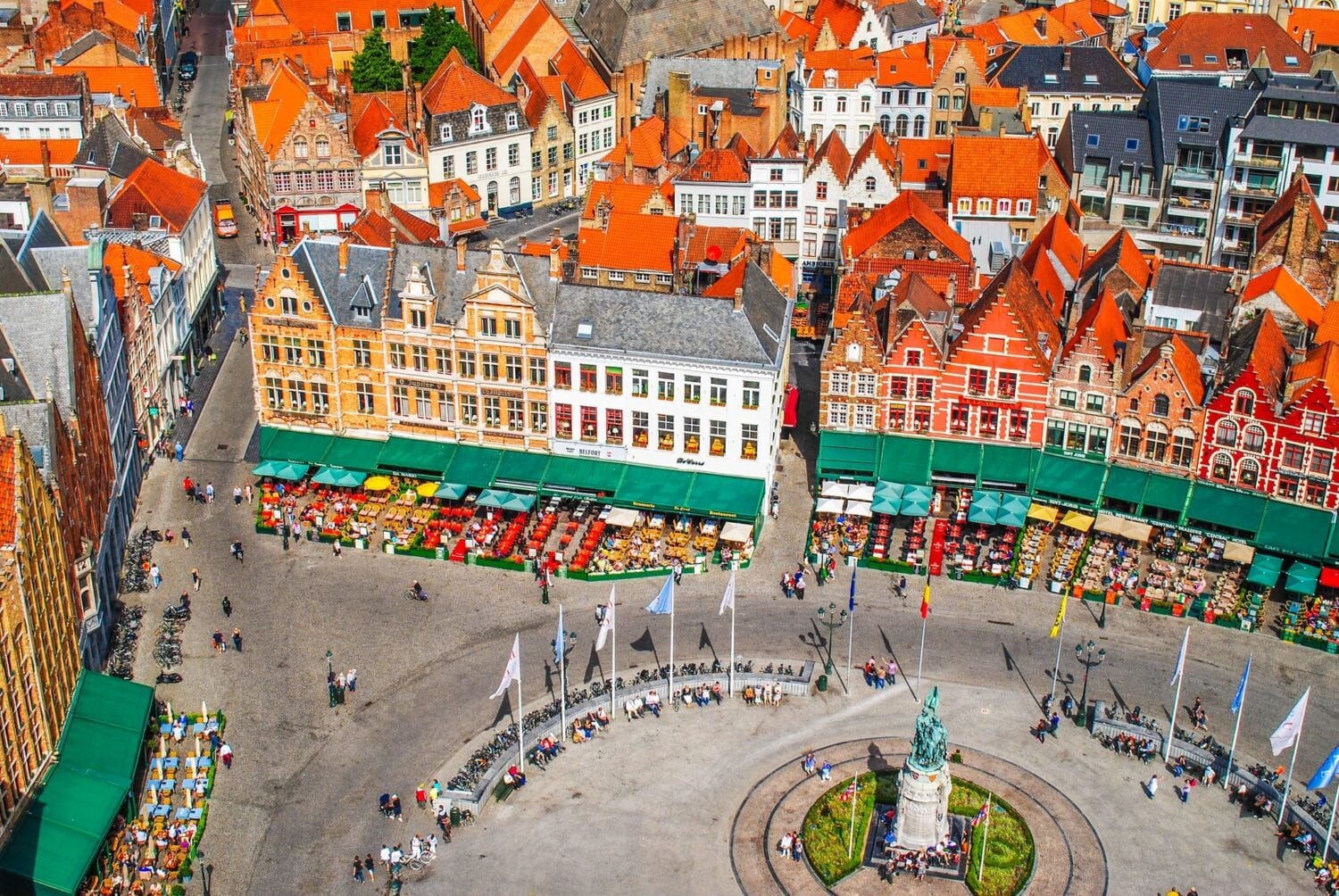
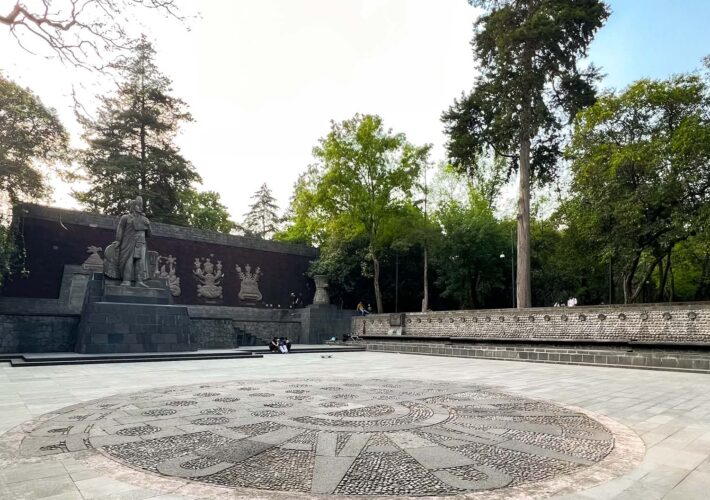
Leave a Comment